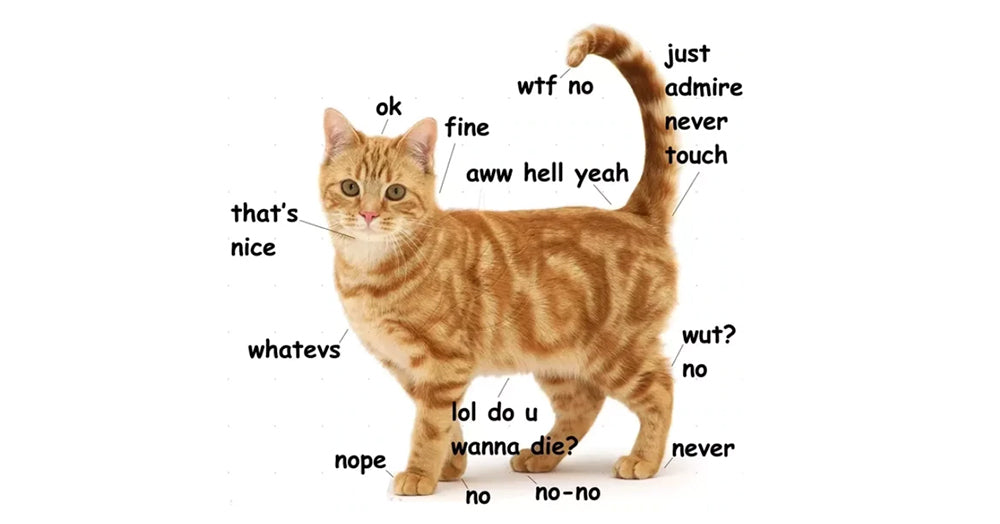Where Cats Actually WANT To Be Pet
Petting cats can be considered an art form. It's comforting, and studies have shown that petting a cat (or dog) actually releases the feel-good hormone oxytocin in humans. And while some people would consider themselves Professional Cat Petters, for newcomers to the cat parent world, petting a cat can be tricky business.

It's a tale as old as time: human pets cat, cat doesn't like it, human gets swatted. It can be a bit frustrating when all you want to do is pet your cat but they don't seem all that into it.
But it's important to understand that your cat isn't swatting at you out of spite or hatred. You're likely just petting it where it doesn't really like to be pet. Like when someone tickles you without your permission - it's not really all that fun!
For new cat owners and old cat owners alike, here are some tips on understanding how and where to pet your cat so that they actually enjoy it.
Pet Here, Please
The places that cats tend to enjoy being petted are those where their scent glands are concentrated. Ever wonder why your cat rubs their face on you or the edges of their favorite cardboard box? When a cat does this, they are leaving their scent behind and letting everyone know, "This is mine!" Spreading its scent makes a cat happy and content because it makes their environment smell familiar and feel safe.

So when you pet a cat in these spots, you're adding to this feeling of contentedness and safety. So, what are these scent-concentrated spots?
- The Chin. Rub or gently scratch your cat along the underside of the chin, focusing on where the jawbone meets the skull. My cat loves to have his chin and face scratched, and will push his head in for more pets.
- Base of Their Ears. When your cat bumps his head against you - called "bunting" - he'll often concentrate on rubbing his ears on you, which is where more scent glands are located. Try giving the base of his ears some gentle scratches or rubs.
- Cheeks, Especially Behind the Whiskers. This spot is also great for scent marking, and it's also the purrfect place for a mini massage. You can use your fingers or a cat face massager to really give your kitty the perfect pet!
- Base of Their Tail. Also known the “Elevator Butt," when you gently caress or pet your cat down the back with a gentle pressure at the base of the tail, you're guaranteed to get a purr.
Associate Pets With Grooming
Cats are fastidious groomers and can often use it as a form of self-soothing and stress relief. Have you ever noticed your cat licking itself after it gets frustrated or anxious? He's self-soothing.
A great way to pet your cat so that they enjoy it and take comfort from it is to incorporate it into their grooming regimen. A grooming glove allows you to brush your cat while still giving them the tactile feel of being pet in their favorite places.
Approaches to Petting
Cats communicate almost entirely through body language, and some of the signs can be subtle and easy to miss - and really easy to misinterpret, especially if you're new to cat parenthood. Pay attention to their ears, eyes, whiskers, and tail. These signals will let you know whether your cat is in the mood to be pet.
For example, if your cat rolls around on the floor and exposes their belly, it's not always an open invite to give pets, like it often is in dogs. When a cat shows you its belly, it is saying, "I trust you." By exposing their vulnerable underbelly, they're letting you know that they trust you enough not to attack them. This isn't necessarily an invite to pet their belly ... if you don't pay attention to the cats other signals, belly pets can often end up something like this:

But every cat is different - and your cat may LOVE belly rubs! It's all about getting to know your cat's preferences.
A calm, happy cat will have their ears and whiskers pointed forward, and their tails will be calm or still. If they're standing, a happy cat will have its tail raised high.
An angry or stressed cat will have its ears and whiskers flat and pointed backward. Their tail may be lashing back and forth - and unlike dogs, this isn't a sign of excitement or happiness, it is a sign of anger, frustration, or stress. If your cat is giving you these signals, they are not likely in the mood to be touched or petted.
Because, let's be honest - sometimes even us humans aren't in the mood to be touched. Let's say you hate someone tickling your toes and get upset whenever someone (say an older sibling) tickles you. The same goes for your cat!
If you pay attention to your cat's body language and focus on these key spots and find out what kind of pets your cat likes best, you'll be a bona fide cat whisperer in no time!

















My cat loves being pet on his belly.
Leave a comment